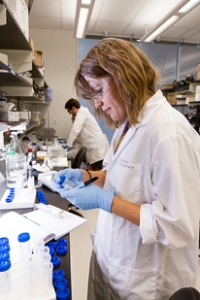Growing use of nanomaterials in manufactured products is heightening concerns about their potential environmental impact – particularly in water resources.
 Natalia von Reitzenstein, an ASU environmental engineering doctoral student, will work with engineering professor Paul Westerhoff on a “nanoprospecting” project. One of their goals is to develop advanced methods of extracting nanomaterials from water so that the amounts of the materials in various kinds of waterways and water systems can be accurately measured. Photo by: Jessica Slater/ASU
Natalia von Reitzenstein, an ASU environmental engineering doctoral student, will work with engineering professor Paul Westerhoff on a “nanoprospecting” project. One of their goals is to develop advanced methods of extracting nanomaterials from water so that the amounts of the materials in various kinds of waterways and water systems can be accurately measured. Photo by: Jessica Slater/ASU
Tiny amounts of materials such as silver, titanium, silica and platinum are being used in fabrics, clothing, shampoos, toothpastes, tennis racquets and even food products to provide antibacterial protection, self-cleaning capability, food texture and other benefits.
Nanomaterials are also put into industrial polishing agents and catalysts, and are released into the environment when used.
As more of these products are used and disposed of, increasing amounts of the nanomaterials are accumulating in soils, waterways and water-systems facilities. That’s prompting efforts to devise more effective ways of monitoring the movement of the materials and assessing their potential threat to environmental safety and human health.
Three Arizona State University faculty members will lead a research project to help improve methods of gathering accurate information about the fate of the materials and predicting when, where and how they may pose a hazard.
Their “nanoprospecting” endeavor is supported by a recently awarded $300,000 grant from the National Science Foundation.
Paul Westerhoff is the lead investigator for the project. He will team with Pierre Herckes and Kiril Hristovski.
Westerhoff is the associate dean of research for ASU’s Ira A. Fulton Schools of Engineering and a professor in the School of Sustainable Engineering and the Built Environment.
Herckes is an associate professor in the Department of Chemistry and Biochemistry in ASU’s College of Liberal Arts and Sciences. Hristovski is an assistant professor in the Department of Engineering in the College of Technology and Innovation.
“We will be working to improve techniques for finding out what nanomaterials are out there in the environment, and what amounts are out there,” and how to determine under what conditions the materials might affect ecosystems, primarily aquatic systems, Westerhoff explains.
The effort will also include finding ways to extract nanomaterials from water and accurately measure the amounts of them in various kinds of waterways and water systems.
The research will be conducted as part of ASU’s Sustainable Water Initiative. Findings from the research will become part of the data archives of National Science Foundation’s Central Arizona-Phoenix Long-Term Ecological Research program at ASU.
The team will share results of the research with the public through the Center for Nanotechnology and Society at ASU.
The project grant will allow for a graduate student to assist in the research and participate in Science Outside the Lab, a two-week seminar in Washington, D.C. that explores how science and engineering research can shape public policy.